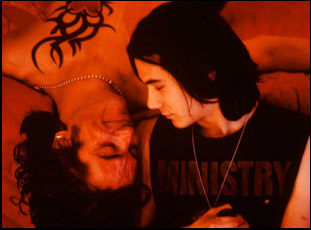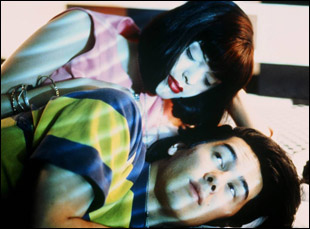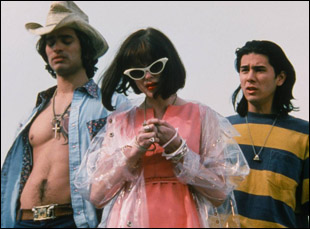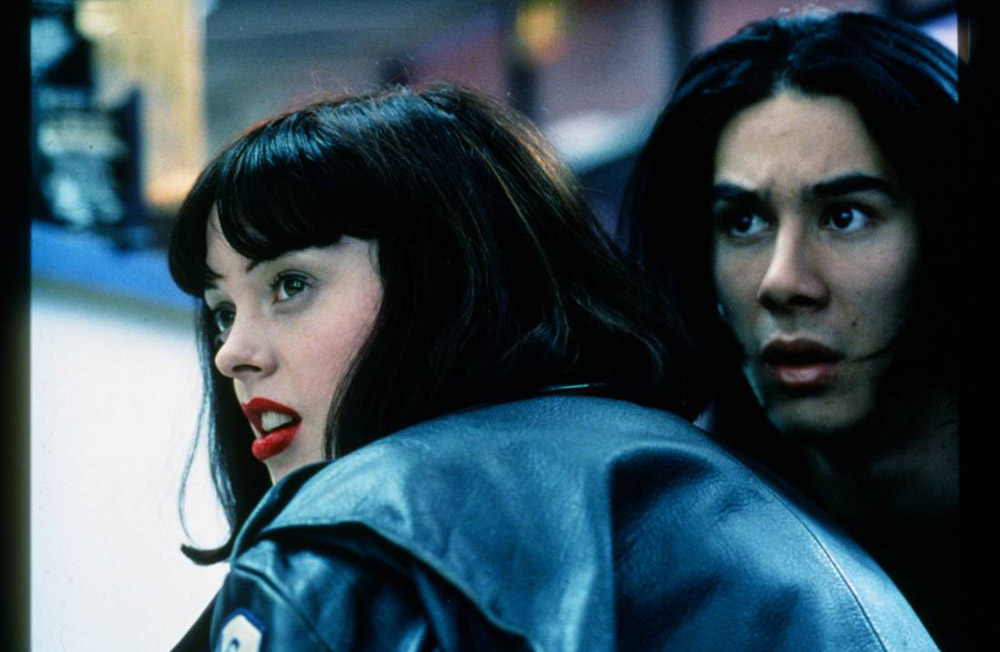“You ever feel reality is more twisted than dreams?” Jordan White (James Duval) asks Xavier Red (Johnathon Schaech) at one point in “The Doom Generation,” which may have come across as disillusionment at the time of the release of Gregg Araki’s exuberant 1995 road trip through hell, quite literally ushering in audiences through flaming gates of an wild underground rave touted as Satan’s lair though it seems to be the world outside that’s on fire. In the years since its release, however, Jordan’s half-in-the-bag observation now seems more clear-eyed and prophetic in terms of the film itself, which has had a road back to the big screen that is nearly as outrageous as anything Araki, one of cinema’s great provocateurs, could ever come up with when “The Doom Generation” has rarely been publicly available, even in its intended form, yet has continued to loom large in a culture still trying to catch up to its cool.
Araki could only surrender to this strange predicament when he arrived to screen a new 4K restoration of the film at the Egyptian at this year’s Sundance, the same place it screened 28 years earlier and unlikely to know a day had passed as he stood alongside Duval and his co-pproducer Andrea Sperling for a Q & A, except for the fact that his former assistant Kim Yutani now was the festival’s director of programming. (“It was a super full-circle moment for her to be doing the Q &A,” the director says now.) For the phantasmagorical experience that Araki envisioned where scenes from the wild ride taken by Jordan, Red and Amy Blue (Rose McGowan) across the brutal landscape of post-Reagan America are often set in a sea of pulsating red or in one particular striking flourish from future “Black Swan” production designer Therese DePrez, a checkerboard room, the explosion of colors that rippled off the screen unfiltered for the first time since its premiere might’ve been triumphant enough, but so enmeshed in the moment in which it was made, featuring cameos from Margaret Cho, Heidi Fleiss and Perry Farrell all amped up by music from Jesus and Mary Chain and Apex Twin, that “The Doom Generation” arrives now as scenic and concise as a postcard from an alternate dimension that brings the world we live in currently into greater focus.
The new presentation doesn’t only reflect Araki’s original vision for the film literally, but substantively as well when the only way one could watch “The Doom Generation” since its release aside from the heroic rep programmers that could get their hands off a print for midnight screenings was a pan & scan home video version where it wasn’t only the frame that was trimmed, but scenes as well to make it more palatable for Blockbuster to carry on its shelves – and less comprehensible for any normal viewer. The notoriety of entering the world unrated had less obvious benefits and consequences than it likely seemed at the time when like many of Araki’s films such as “Nowhere” (which never even received a home video release but will soon be getting a 4K restoration of its own), the imagination could reel with possibilities for those prevented by age at first and then proper distribution, but in spite of the titillating promise of sex and violence, it is far more playful and innocent than one might expect as its central trio tries to define the lines in their relationship rather than crossing over them, a transgressive attitude towards romantic entanglement that Araki would revisit time and again in his career.
With the film kicking off a theatrical run across the country with events this week at BAMCinematek and IFC Center where Araki will appear with the film as well as the Music Box Theater in Chicago, the filmmaker spoke about seeing the film with fresh eyes, the pivotal moment it played in his career when he had a full-fledged production crew behind him for the first time and how he wanted to honor another filmmaker who took the tradition of the American road movie on a grand detour with a screening of “Something Wild” that he’ll be presenting on Friday at the IFC.

It was really thrilling to revisit the movie and I remember when we did the remaster, I was talking to Marcus [Hu], the distributor, and just saying, I had forgotten what a beautiful movie it is. Jim Fealy, the cinematographer and the production designer, the late, great Therese DePrez, did such a phenomenal job with a very limited indie budget. and all of the cast are just so gorgeous. The old video copy of it was not even letterboxed and there’s stuff we fixed in terms of the color timing and we remixed the sound, so it’s just a brand new version of the movie. And so it was really great to be able to go back and touch it and really make it the best version that it can be. I’m so glad that it’s been restored to how it should have looked all this time — and it’s never looked like this before.
And when we made this movie, it was just this artsy punk project that we had no idea what was gonna happen to it. It was just a very low budget indie movie that was just a big, fun adventure for us and the fact that 28 years later, we’re still talking about it and it’s had this restoration and an incredibly loyal and devoted cult following that has been rooting for it all these years…I’ve been talking to so many people that have told me how meaningful the film is to them and it’s such an incredibly humbling experience. That’s what’s super special to me — the idea that this movie has meant so much to so many people for so long is mind boggling.

It’s funny because when we screened at Sundance [this year] before the movie started, I asked the audience, how many people in this theater have never seen the movie? And I swear 80% of the audience raised their hand, so when we screened it, it was like a brand new audience. And there’s a strange awareness amongst people, [particularly a] newer generation, who have seen [scenes from] the movie, like Vines and TikToks and Pinterest — I’m not on social media, so I don’t really know anything about this stuff. But this movie and “Nowhere” both have lived this strange afterlife amongst this generation that was too young to see the movie the first time around, so there’s a real curiosity about it, which I find fascinating.
And [the restoration] is screening so many places across the country — I think more cities than it screened when it was originally released in the ‘90s. When it was released, it didn’t get that much theatrical distribution, and the cult phenomenon of “The Doom Generation” really has happened in the years after that amongst with DVDs and VHSs and people seeing some weird bootleg copy online, [which is] why, again, I’m excited about the re-release because very few people have seen the movie the way it’s supposed to be seen. It really is such a cinematic experience and so fun to watch it in a big theater with the audience reaction, so I couldn’t be more excited about the re-release of it.

Yeah, it was the Northridge earthquake and all other kinds of stuff going on. But I look back on it now and it was really such a magical experience. I have such fondness for it. It was a very crazy, chaotic shoot and everything about it was just so much a part of my life right then. It was really such a special experience to make that movie and I remember when Parker came in, she literally just flew off for that one day and we were so grateful and fortunate to have her. Her performance in that scene is absolutely iconic and I worship her in general, but I worship her in that scene so much.
This was your first time working on a bigger production, right? Your first films were largely DIY.
Yeah, “Doom Generation” was actually my fifth movie, but my first four movies were all on 16 millimeter and I DP’d them myself and the crew was usually sometimes four or five people, and sometimes it was just one person, so they were really DIY efforts. This was my first movie that had a DP and a production designer and a costume designer and ADs, so it was definitely a leap, but in terms of the process of it, it was very similar in the sense that I really had the movie in my head in the way that I had all my previous movies in my head, so it was just a matter of learning how to realize my vision with the collaboration of a crew.
And the cast was amazing. Jimmy [Duval] had done “Totally Fucked Up” with me before and I wrote “Doom Generation” for him and Rose [McGowan] had not really done any movies. She was like an extra on “Encino Man” or something, and then Johnathon [Schaech] had done a couple of movies, but just to have them at that point in their careers was incredible. They did such an amazing job. And then the supporting cast too is just such a great group of people that were really ready to explore and go on this adventure with me.

This was really a super special experience. I remember to get the Nine Inch Nails and the Porno for Pyros songs, we had to screen the movie for Trent Reznor and Perry Farrell, so we had a special private screening just for them. And we didn’t have very much money [even for this] and the fact that we got these amazing iconic bands to let us license their music for the movie was incredible. But the movie is so much inspired by the spirit of post-punk alternative music that it really couldn’t live without it, so that’s why I’m so happy about the soundtrack of the movie. One of the things I don’t like about the first sound mix is that you can’t hear a lot of the music very well. But in the re-release it’s really, you can hear the songs and [with] the remixed sound, we really pumped the music up.
I wouldn’t want to steal any thunder from your introduction, but it’s really lovely that while in New York, you’ll also be introducing a screening of Jonathan Demme’s “Something Wild” this weekend. How did that come about?
It was just really weird. When they said, what movie do you want to show at IFC [Center], I love Godard movies, and there’s so many movies that are on my top 10 of all time, but then out of the blue, “Something Wild” just popped in my head, and I had not seen it for decades. I haven’t seen it for so long, but I wanted to pay homage to Demme. He was really an inspiration to me when I was younger, and he was a bit older than me, but he was very also inspired and immersed in sort of the post-punk alternative music scene. He did that famous New Order video [“The Perfect Kiss”] and he made “Stop Making Sense” with the Talking Heads and he was very in that scene in the way that I was, and the music and the spirit of post-punk music, I know really inspired him in the way that inspired me. He was just a a spiritual godfather in the sense that he was several steps ahead and you can tell in “Something Wild” he’s very much a film school-y director, even though he didn’t go to real film school. His films reference the classics of Hitchcock and Hawks and Ford and he just really knew his cinema history so well, and it really influenced his work. That was a big influence on me and when I rewatched “Something Wild” recently, I was just blown away by it. It’s so very much related to “Doom Generation” — the structure is very similar and the abrupt shifts in tone from the romantic sex comedy stuff to the lurching violence, so I was so pleased to be able to pick that movie.
“The Doom Generation” opens on April 7th at the Music Box Theatre in Chicago and the IFC Center in New York. It will expand across the country on April 14th and screen at the Los Feliz 3 in Los Angeles on April 20th, April 21st and April 24th. A full list of cities and dates is here.




